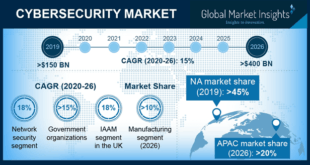Throughout much of the world, food and beverage safety and security is a high priority. Concomitantly, the economics, societal robustness, and security implications of agriculture, foodstuffs and beverages are massive. Extensive quality measures are in place to prevent and mitigate threats from manifesting; outbreak and contamination detection and response systems …
Read More »With Rising threat in Space domain from Electronic to Cyber Warfare, Space agencies enhancing Cyber security measures
Space is increasing becoming another domain of conflict due to enhanced militarisation i.e. utilisation of space systems by defence forces to support military operations as well as space weaponization with the proliferation of counter-space weapons. There are a variety of threats to space systems, from Direct ascent and co‐orbital anti-satellite …
Read More »Cyber Warfare threat driving Defense Cyber Security market and new security technologies
In 2019, 1,473 data breaches in the U.S. led to the exposure of 164,683,455 confidential records, as per the Identity Theft Resource Center (ITRC). Additionally, in May 2020 alone, 841,529 records were exposed in 108 data breach incidents. The records ranged from people’s financial and medical information to strongly protected …
Read More »Quantum secure direct communication (QSDC)
Quantum communication refers to a quantum information exchange that uses photons as quantum information carriers over optical fibre or free-space channels. Today, quantum data transfer rates remain quite low, and so communicating entire messages is not yet practical. Instead, Quantum Cryptography or Quantum key distribution (QKD) is being used …
Read More »Remote Security Assessment System (RSAS)
Network vulnerabilities are an increasingly common issue in today’s highly complex computing environments. With exploit attacks appearing faster than ever before, it has become significantly more challenging for organizations to protect against attacks. Only if users could discover these vulnerabilities in their network and proactively get ready before attackers take action, can the losses …
Read More »DARPA Report Finds Vulnerabilities in Blockchain Crypto Transactions
Distributed ledger technologies commonly known as the blockchain, refer to software that stores information on a secure, decentralized network where users need specific cryptographic keys to decrypt and access data. Cryptocurrencies, such as the popular Bitcoin, are networks built on the blockchain, a financial ledger formatted in a sequence of …
Read More »Threat of Quantum computer to Blockchain , Researchers propose Quantum Resistant Ledger (QRL) and Quantum blockchain
Blockchain, is a growing list of records, called blocks, which are linked using cryptography. Blockchains which are readable by the public are widely used by cryptocurrencies. Private blockchains have been proposed for business use. Blockchain a transformative decentralized digital currency, a secure payment platform free from government interference, is being considered …
Read More »International cyber diplomacy and security
Information and communication technology present new challenges to international affairs.The scale and speed of technological advancements in cyberspace are unprecedented. As the fourth industrial revolution dawns, bringing with it the reality of big data, artificial intelligence, and quantum technology, the world is entering a new level of more sophisticated hypoconnectivity, …
Read More »Cyber threats and CyberSecurity technology trends
Cyber threats have become an increasingly important issue for businesses and individuals alike. As technology continues to evolve and become more integrated into our daily lives, cyber criminals are finding new and innovative ways to exploit vulnerabilities in the digital world. Cyberattacks are frequent and increasingly complex, perpetrated by …
Read More »Cyber threats of Cryptocurrency and Cryware
Bitcoin is a digital currency that allows for the transfer of payment between two parties, without the help of a bank—and without government oversight. On average, more than 250,000 bitcoin transactions occur every day, and with a market capitalization in excess of $66 billion, bitcoin has become the largest cryptocurrency in …
Read More » International Defense Security & Technology Your trusted Source for News, Research and Analysis
International Defense Security & Technology Your trusted Source for News, Research and Analysis


